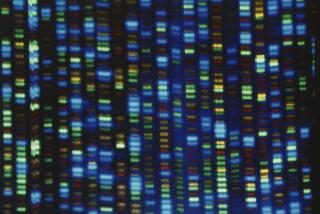The 100-Million Species Question: What Are They?
- Share via
An eclectic band of scientists, Silicon Valley millionaires and media celebrities is mounting an ambitious effort to catalog every living species on the planet within the next 25 years.
From the bright sunflowers in the local park to the white-tailed deer in Siberia, from the wild yam in South Africa to the pink dolphin in the Amazon River--every living plant and animal is supposed to make it onto the list.
It is a grand--and perhaps overly optimistic--project, given that it has taken Homo sapiens 2 1/2 centuries to identify just 1.5 million to 1.8 million species. Some scientists, such as Harvard sociobiologist Edward O. Wilson, believe there could be well over 100 million species of animals, plants, insects and other living organisms on Earth.
But despite the size of the task, supporters of the All Species Inventory Project believe the process of scanning all life on the planet will eventually pay big dividends.
“Discovering and understanding the diversity of life on Earth is not just a grand intellectual challenge--it is also critically important,” said David M. Hillis, professor of integrative biology at the University of Texas at Austin. “The fact is that we are largely ignorant of our own planet and how it works.”
So far, about 70 scientists from around the world have joined the effort, which is being organized and managed by the not-for-profit All Species Foundation in San Francisco.
The list of advisors to the foundation includes Oxford evolutionary biologist Richard Dawkins, Wired magazine founding editor Kevin Kelly and Whole Earth Catalog creator Stewart Brand.
The foundation hopes that names like these will help draw the estimated $3 billion to $5 billion it will take to complete the directory. It is focusing its fund-raising efforts on the enormous private wealth generated by the New Economy.
The organization’s founding grant of $1 million came from foundation advisor Evert I. Schlinger, professor emeritus of entomology at UC Berkeley. In addition, the Gordon and Betty Moore Foundation, established by Intel Corp. co-founder Gordon Moore, has contributed $56,000; and Shel Kaphan, Amazon.com’s first employee and former chief technology officer, has contributed $100,000.
While few scientists dispute the value of an inventory of life, some have questioned the effectiveness of the project, saying that cataloging every living thing is simply unrealistic.
“These sorts of things are very useful to raise public consciousness, but what worries me is that it is inherently unachievable,” said Craig Moritz, professor of molecular evolution at UC Berkeley. “Why are we, as scientists, making some sort of promise that we can’t deliver on? We’re never going to know all the species that are out there.”
But the project members believe they can make enormous headway on their admittedly ambitious goal through the use of high technology.
“There are a few advantages that the next 25 years offer, which the previous 250 years did not,” said Richard Pyle, an ichthyologist at the Bishop Museum in Honolulu and a consultant to the foundation. “My interest is deep coral reefs. Just 10 to 15 years ago, the cost and time required to just get a person to those depths was astronomical.
“Recent advances in diving technology, however, now allow me to access this realm at costs that are less expensive than before.”
The Internet also opens possibilities for organizing and collecting information for the project. While it used to take taxonomists many months, sometimes years, to distribute information about new species, they can now post their news on the Web in a matter of minutes. They can also build online databases, which will help them organize and coordinate their research.
Such improvements in technology, along with the development of new scientific tools such as rapid DNA sequencing, give these biologists reason to hope--and count.
“In the absolute sense, we won’t ever know for sure,” said Hillis, of the University of Texas. “And there likely will be a few occasional species that will continue to be discovered....
“However, we will know that we are essentially complete when we can take a random sample of organisms from any spot on Earth and identify them all. Right now, we can’t begin to do that for any spot on Earth.”






